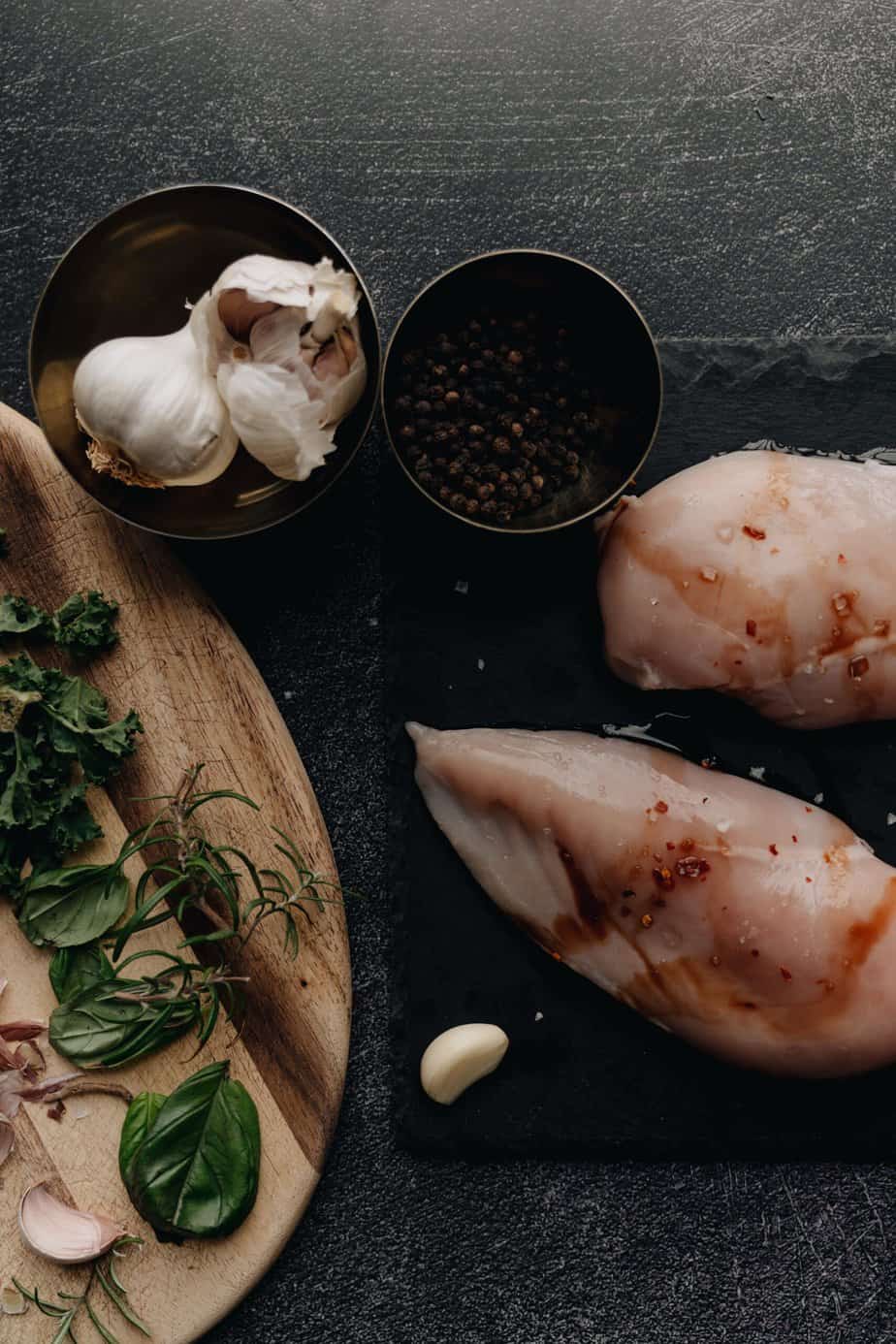How to Defrost chicken? Its simple. Put the chicken in a defrost tray, and put it on a low shelf for at least 2 hours or until no longer frozen. There are also other ways to defrost chicken more quickly such as refrigerator thawing, microwave thawing, cold water thawing.
This guide specifically addresses how to defrost chicken, providing a step-by-step approach to thawing your chicken safely. This guide also delves into the nuances of refrigerator thawing, microwave thawing, cold water thawing ensuring your chicken remains free from bacterial danger while preserving its quality.

From setting the right temperature to timing and placement, we cover each aspect to make this process seamless for you. Whether you’re planning a simple family dinner or a gourmet meal, understanding this method is key to ensuring your chicken is perfectly thawed, maintaining its texture and flavor for a delicious result.
Get ready to learn the safest way to defrost chicken, backed by the expertise of food safety entities and seasoned culinary experts.
Why Proper Defrosting of Chicken is Crucial
When it comes to preparing chicken, defrosting is just as important as the cooking process itself. Correctly thawing chicken is crucial for maintaining both food safety and the quality of your meal. In this section, we explore why proper defrosting is a must in every kitchen.
Food Safety Concerns
Defrosting chicken improperly can lead to the growth of harmful bacteria such as Salmonella and Campylobacter, posing a risk of foodborne illnesses. The danger zone for bacterial proliferation is between 40°F and 140°F, a range easily reached during incorrect thawing.
The USDA emphasizes the importance of safe defrosting methods to prevent bacterial growth. Ensuring chicken is thawed at safe temperatures is vital to avoid contamination and protect your health. (Source)
Impact on Taste and Quality
How you thaw chicken can significantly affect its texture and flavor. Freezing creates ice crystals within the muscle fibers. If thawed too quickly, these crystals can damage the fibers, resulting in a loss of moisture and a dry, tough texture.
Proper defrosting techniques help preserve the natural juices of the chicken, ensuring it remains tender and flavorful. This enhances your overall culinary experience, whether you’re grilling, baking, or frying the chicken.

Key Points to Remember for Safe Chicken Defrosting
- Always Thaw Below 40°F: To prevent bacterial growth, keep chicken at or below this temperature.
- Avoid Room Temperature Thawing: This method can quickly enter the danger zone for bacteria.
- Use Correct Methods: Refrigerator thawing, cold water thawing, and microwave thawing are the safest.
- Plan Ahead: Some methods, like refrigerator thawing, require more time.
- Cook Immediately After Thawing: Especially important for microwave thawing to avoid partial cooking.
How to Defrost Chicken Quickly by Refrigerator Thawing
Refrigerator thawing is widely recommended as the safest and one of the quick ways to defrost chicken. This method is praised for its ability to maintain a constant, safe temperature. Let’s dive deeper into how to efficiently use this method.
Steps and Time Required for Refrigerator Thawing
To thaw chicken in the refrigerator, plan ahead, as it takes at least 24 hours for every 4-5 pounds of chicken. Place the chicken in a leak-proof bag or container to prevent cross-contamination and set it on the lowest shelf to avoid drips on other foods.
The size of the chicken determines the thawing time. A whole chicken or larger cuts will require more time, typically around 24 hours for every 5 pounds. Smaller pieces, like chicken breasts, may thaw overnight. Keeping the refrigerator temperature at or below 40°F is crucial throughout this process.
Advantages and Drawbacks
The primary advantage of refrigerator thawing is its safety. By maintaining a steady, low temperature, it effectively prevents the growth of harmful bacteria. This method also preserves the chicken’s texture and moisture, ensuring a better cooking result.
The drawback is the time it takes, requiring significant advance planning. This might not be suitable for quick meal preparations. However, the safety and quality benefits often outweigh this inconvenience.
Refrigerator Thawing Guidelines for Defrosting chicken
| Chicken Type | Thawing Time |
|---|---|
| Whole Chicken | 24 hours per 5 pounds |
| Chicken Cuts | 24 hours |
| Chicken Breasts | Overnight (12-24 hours) |
Tips on how to defrost chicken in fridge
- Plan Ahead: Allow sufficient time based on the chicken’s weight.
- Temperature Check: Ensure the fridge is at or below 40°F.
- Leak-Proof Packaging: To prevent juices from contaminating other foods.
- Lower Shelf Placement: For hygiene and to prevent drips.
- Post-Thawing Handling: Cook thawed chicken within 1-2 days for optimal safety and quality.
Defrost Chicken Using the Cold Water Thawing Method
Thawing chicken in cold water is a quicker alternative to refrigerator thawing. This method is especially useful when you need to defrost chicken more rapidly while still maintaining food safety standards. Let’s explore the steps involved and the reasons why cold water thawing is effective and safe.
Procedure for cold water thawing and Precautions
Start by placing the chicken in a leak-proof plastic bag to avoid water seeping into the meat and potential cross-contamination. Fill a large bowl or sink with cold water, ensuring the temperature is below 40°F. Submerge the bagged chicken completely.
It’s crucial to change the water every 30 minutes to maintain the cold temperature. Keep an eye on the thawing process to ensure even defrosting and avoid leaving the chicken in water for an extended period once thawed.
Time Efficiency
Cold water thawing is considerably faster than refrigerator thawing. Small cuts like chicken breasts can thaw in about 1-2 hours, while larger cuts may take a few hours.
Despite its speed, this method requires active participation, as the water needs regular changing. It’s a balance between time efficiency and the effort involved in monitoring the process.
Cold Water Thawing Times for Defrosting chicken
| Chicken Cut | Approximate Thawing Time |
|---|---|
| Small Chicken Breasts | 1-2 hours |
| Large Chicken Cuts | 2-3 hours |
| Whole Chicken | 3-4 hours |
Key Points on how to defrost chicken in water
- Use Leak-Proof Bags: Prevents water from contaminating the chicken.
- Maintain Cold Water: Change water every 30 minutes.
- Monitor Thawing Process: Ensures even and efficient defrosting.
Microwave Thawing
Microwave thawing is a rapid method to defrost chicken, ideal when time is of the essence. Although quick and convenient, it requires careful attention to prevent uneven thawing and overcooking. This section outlines the steps and considerations for using your defrosting chicken using microwave effectively and safely for defrosting chicken.
Instructions and Safety Tips
To begin, remove the chicken from its original packaging and place it on a microwave-safe plate or dish to catch any juices. Set the microwave oven to the defrost setting or 30-50% power, depending on your model. This lower power level helps prevent the chicken from cooking during defrosting.
The defrosting time generally depends on the weight of the chicken, with a guideline of about 2 minutes per pound. It’s important to check the chicken regularly, flipping and rotating it to ensure even thawing. Avoid overextending the defrosting time, as this can lead to partially cooked areas where bacteria might proliferate.
When to Use This Method
Microwave thawing is best suited for smaller cuts of chicken, such as breasts or thighs. It’s not recommended for a whole chicken, as the thicker parts may not defrost evenly. This method is particularly useful when you’re short on time and plan to cook the chicken immediately after defrosting.
Microwave Thawing Guidelines for Defrosting chicken
| Chicken Cut | Approximate Thawing Time |
|---|---|
| Chicken Breast | 2-3 minutes per pound |
| Chicken Thigh | 2-3 minutes per pound |
| Whole Chicken | Not recommended |
Key Points on how to defrost chicken in oven
- Use Correct Power Settings: Defrost setting or 30-50% power.
- Regular Checks: Flip and rotate chicken for even thawing.
- Avoid Over-Thawing: Overcooking can occur if left too long.
- Immediate Cooking: Cook chicken right after thawing.
- Suitable Cuts: Best for smaller cuts, not whole chickens.
By understanding and applying these microwave thawing techniques, you can safely and efficiently prepare your chicken for cooking, ensuring both food safety and quality.
How to Defrost Chicken in Refrigerator
Defrosting chicken in the refrigerator is a safe and reliable method, ensuring that your chicken remains at a safe temperature throughout the thawing process. Here, we will guide you through the steps to defrost chicken in your refrigerator, providing tips to make the process efficient and safe.
Planning and Preparation
Planning is essential when defrosting chicken in the refrigerator. Small cuts of chicken, like breasts or thighs, typically thaw within 24 hours. Whole chickens, however, may require more time, often up to 48 hours or longer, depending on their size.
To begin, place the chicken in a leak-proof plastic bag to prevent any juices from contaminating other foods in your refrigerator. Position the bagged chicken on the bottom shelf to minimize the risk of cross-contamination. This shelf placement also helps maintain an even temperature for the chicken.
Thawing Time and Temperature
The key to safe refrigerator thawing is ensuring the temperature of your fridge is set at or below 40°F (4°C). This temperature slows bacterial growth and keeps the chicken in a safe zone. Use a refrigerator thermometer to monitor the temperature.
Check your chicken periodically to gauge the thawing progress. Once thawed, it’s best to cook the chicken within 1-2 days to ensure quality and safety. If you’re unable to cook the chicken within this timeframe, you can safely refreeze it without cooking.
Refrigerator Thawing Guidelines for Defrosting Chicken
| Chicken Cut | Thawing Time |
|---|---|
| Small Chicken Cuts | 24 hours |
| Whole Chicken | 24-48 hours or longer |
Refrigerator Thawing Tips
- Maintain Safe Temperature: Keep your fridge at or below 40°F.
- Use Leak-Proof Bagging: To prevent cross-contamination.
- Bottom Shelf Placement: For safety and even temperature.
- Monitor Thawing Progress: To ensure proper defrosting.
- Cook or Refreeze Promptly: Within 1-2 days after thawing.
By following these steps and guidelines, you can defrost chicken in your refrigerator safely and effectively, ensuring it’s ready for a delicious and safe meal. Remember, the key is to plan ahead and maintain the right temperature, ensuring your chicken thaws evenly and remains safe to consume.
How to Defrost Chicken using Defrosting Trays
Defrosting trays are an innovative tool for thawing chicken, offering a balance between speed and safety. Made from materials like aluminum, these trays use the principle of heat conduction to accelerate the thawing process without additional heat or electricity. Let’s examine how defrosting trays work and their advantages in your kitchen routine.
How Defrosting Trays Work
Defrosting trays are designed to transfer ambient room temperature to the frozen chicken more efficiently than air alone. The metal’s high thermal conductivity pulls the cold from the chicken, allowing it to thaw quicker. The room temperature affects the speed, with warmer conditions leading to faster thawing.
Some trays come with additional features like raised legs for air circulation, drip trays to catch water, reversible cutting board sides, and cleaning tools. These enhancements contribute to a more efficient and clean defrosting process.
Pros and Cons of defrosting chicken using defrosting trays
The main advantage of defrosting trays is their ability to thaw chicken quickly, typically within 30 to 60 minutes, depending on the size and thickness of the meat. They’re easy to use, don’t require preheating or electricity, and can be a more eco-friendly option compared to other methods.
However, these trays might not be suitable for very large pieces of chicken, like a whole bird. The thawing time can also vary based on the room temperature and the tray’s material. Some users report that the trays can be hard to clean, especially if they have a textured surface.
Defrosting Tray Features
| Feature | Description |
|---|---|
| Material | Typically aluminum or metal with high conductivity |
| Additional Features | Legs, drip trays, reversible sides, cleaning tools |
| Defrosting Time | Ranges from 30 to 60 minutes |
| Size | Varies, typically large enough for multiple servings |
Tips for Using Defrosting Trays
- Preparation: Place chicken on the tray without any packaging.
- Room Temperature: Ensure the kitchen isn’t too hot.
- Regular Checking: Flip the chicken to ensure even thawing.
- Cleanup: Use the included tools or a gentle brush to clean the tray.
- Storage: Some trays come with handles for easy hanging.
Defrosting trays offer a convenient and quick way to thaw chicken, suitable for various kitchen setups. Their efficient design and additional features can make them a valuable addition to your kitchen, especially for those who frequently cook with frozen chicken.
Comparison of Different Methods for Defrosting Chicken
| Method | Description | Time Required | Safety | Convenience |
|---|---|---|---|---|
| Refrigerator Thawing | Thawing chicken in the refrigerator over a period of 24 hours per 4-5 pounds. Safest method, maintaining a consistent, low temperature. | 24 hours per 4-5 pounds | Highest – maintains safe temperature | Low – requires planning |
| Cold Water Thawing | Submerging chicken in cold water, changing water every 30 minutes. Takes about 1 hour per pound of chicken. | About 1 hour per pound | Moderate – requires water changes | Moderate – more attention needed |
| Microwave Thawing | Using the microwave’s defrost setting or a low power setting, thawing for 2 minutes per pound. Fastest method, but may lead to uneven thawing. | 2 minutes per pound | Lowest – risk of uneven thawing and cooking | High – quick and easy |
In conclusion, mastering the art of defrosting chicken is crucial for every home cook, balancing food safety and culinary quality. Through our exploration, we’ve uncovered that refrigerator thawing, while slow, is the safest and most consistent method, preserving the texture and flavor of chicken.
Cold water thawing offers a quicker alternative, suitable for those short on time, yet requiring vigilance to maintain safe temperatures. Microwave thawing is the fastest method, best for small cuts and urgent meal preparations, but it demands careful monitoring to prevent uneven thawing.
Defrosting trays, a convenient and eco-friendly option, provide a speedy solution, especially for smaller portions. Each method has its place in the kitchen, tailored to different needs and situations.
Here is an article on some of the best ways to defrost chicken.
Also it is important to know the best ways to defrost frozen foods and how to defrost turkey and how to defrost fish and how to defrost beef.
Is it safe to cook frozen chicken in the oven?
Yes, it is safe to cook frozen chicken in the oven, but ensure that it reaches an internal temperature of 165°F (74°C) to be safely consumed.





